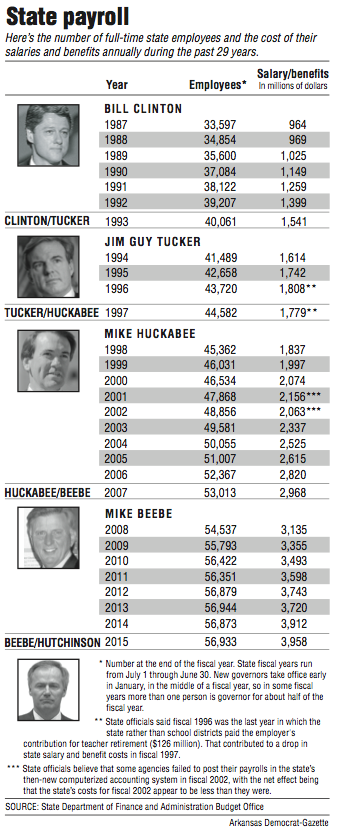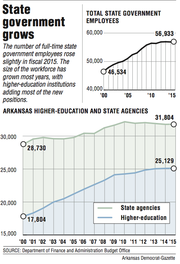The number of full-time state employees in Arkansas increased slightly last fiscal year after dipping the previous year.
The number increased by a net 60 to 56,933 full-time state workers between June 30, 2014, and June 30, 2015, the last day of fiscal 2015, according to a report compiled by state budget administrator Duncan Baird.
The increase was the smallest of any year since 1987, the first fiscal year for which reliable state government workforce figures are available. (In two fiscal years, 2011 and 2014, the number of employees dropped slightly.)
Democrat Mike Beebe was Arkansas’ governor for the first half of fiscal 2015; Republican Asa Hutchinson took office Jan. 13.
“We are trying to keep the [authorized] positions in state government fairly level without growing the size of state government,” said Sen. Uvalde Lindsey, D-Fayetteville, who is co-chairman of the Legislative Council’s personnel subcommittee.
Hutchinson said the state needs to have enough correctional officers for its record prison population, and sufficient faculty and staff members to handle increasing enrollment at community colleges and public universities and to boost the number of college graduates.
“There is pressure for appropriate and understandable and necessary growth in some areas of responsibility that we have,” he said. “But then you’ve also got our initiative on increased efficiencies [in state government] and that’s allowed us to counterbalance some areas of necessary growth.
“I think the net result is that we have not only slowed the growth of state government, but on those agencies that report directly to me we’ve actually reduced the number,” Hutchinson said.
The number of full-time state employees dropped by 71 in fiscal 2011, increased by 528 in 2012 and increased by 65 in 2013 before decreasing by 71 in 2014, according to Baird’s report.
States’ overall employee ranks have grown slightly across the nation in the past few years as the economy improves and states face continued demand in areas such as prisons and human services, said Leslie Scott, executive director of the National Association of State Personnel Executives.
HIGHER EDUCATION
Full-time employees at the state’s higher-education institutions increased by a net 32 to 25,129 in fiscal 2015, according to Baird’s report.
That’s the smallest growth there in at least the past 15 years, based on figures provided by Baird. The schools added 55 employees in fiscal 2014, the second-smallest increase in the past decade and a half.
Brett Powell, director of the state Department of Higher Education, said the slower growth could be because of declining enrollment at the two-year colleges. In addition, “flat state funding, along with pressure to keep tuition increases at a minimum have reduced the amount of funding available,” he said.
Total student enrollment at the two- and four-year colleges has increased from 105,014 in the fall of 2000 to 151,356 in the fall of 2014 — an increase of 44.1 percent, Powell said. Enrollment peaked at 158,606 in the fall of 2011.
The number of full-time employees at these schools has increased from 17,804 in fiscal 2000 to 25,129 in fiscal 2015 — an increase of 41.1 percent — based on Baird’s figures.
During fiscal 2015, the number of full-time employees at four-year universities increased by 71 to 21,974, and decreased by 39 to 3,155 at the state’s two-year and technical colleges
The size of the full-time workforce increased at the University of Central Arkansas in Conway by 142 to 1,299; at the University of Arkansas at Fayetteville by 120 to 3,578 and at the University of Arkansas for Medical Sciences by 69 to 8,702, according to Baird’s report. Arkansas State University in Jonesboro saw its full-time workforce drop by 142 to 1,576.
Graham Gillis, UCA’s associate vice president for human resources, said the actual number of employees at the school had not spiked and the increased figure in fiscal 2015 reflects more nine-month faculty members being counted as full-time employees.
ASU spokesman Jeff Hankins said the Jonesboro campus’s full-time workforce didn’t plummet in fiscal 2015, and that “previous reports were inaccurate due to clerical errors by a former employee. This year the [human resources] department started from scratch.”
Hutchinson said he doesn’t have “direct management control” over the colleges and universities.
“Even though we have to grow in terms of our number of students, if [the higher-education institutions] concentrate on efficiency and the delivery of services with current staff and those efforts, hopefully that will be constrained in terms of its growth,” he said.
OTHER STATE AGENCIES
The number of full-time employees at agencies other than the higher-education institutions increased by a net 28 to 31,804 in fiscal 2015 after dropping in three of the previous four fiscal years, according to Baird’s report.
The number of employees at the Arkansas Highway and Transportation Department increased by 109 to 3,668, the largest increase reported among the agencies.
The increase “reflects where we are in increasing the size of our maintenance staff” after “the harsh winter of 2013/2014 brought to light how underequipped we were both equipment-wise and employee-wise,” said Danny Straessle, a department spokesman.
The number of full-time employees increased by 38 to 4,059 at the state Department of Correction, while their ranks declined by 67 to 1,257 at the Community Correction Department, Baird’s report said.
The Department of Community Correction held “positions [open] because we had an issue making payroll because of the way the [state general revenue] is released, said department spokesman Dina Tyler.
“But [the Department of Finance and Administration] got legislation in this [year’s regular] session that lets us get advances on our money,” Tyler said, adding that the Correction Department already had this ability.
The Department of Human Services’ number of fulltime employees increased by 30 to 7,447, while their ranks at the Department of Finance and Administration increased by 36 to 2,601. The lottery was merged into the finance department in February.
The Department of Health increased its full-time workforce by five to 2,615, according to Baird’s report.
Hutchinson’s spokesman, J.R. Davis, said 323 positions that state agencies asked the governor’s office for permission to fill remain vacant, saving the state about $2.8 million. An executive order from Hutchinson in January required most agencies to get his office’s approval before filling open positions.
The executive order doesn’t apply to higher-education institutions, the Highway Department and the Game and Fish Commission as well as legislative and judicial agencies.
These unfilled positions include 65 positions at the Human Services Department, 61 at the finance department, and 28 at the Health Department, said Davis.
SALARIES AND BENEFITS
State government’s salary and benefit expenditures increased by $44.9 million, or 1.15 percent, to $3.957 billion in fiscal 2015. The size of the full-time workforce increased 0.11 percent.
State employees’ total salaries increased by $14.7 million to $3.058 billion, while total benefit expenses increased by $29.6 million to $899.3 million, the report said.
Most state employees who don’t work at the higher-education institutions received a 1 percent cost-of-living raise in fiscal 2015 and were eligible for merit bonuses of up to 3 percent in fiscal 2015, Baird said.
The average salary of state employees listed on the Arkansas Administrative Statewide Information System is $39,731 compared with $39,320 in December largely as a result of the 1 percent increases, he said.
Except for the higher-education institutions and the Highway Department, most state agencies are on the computerized listing. Comparable figures were not available for the colleges and universities.


